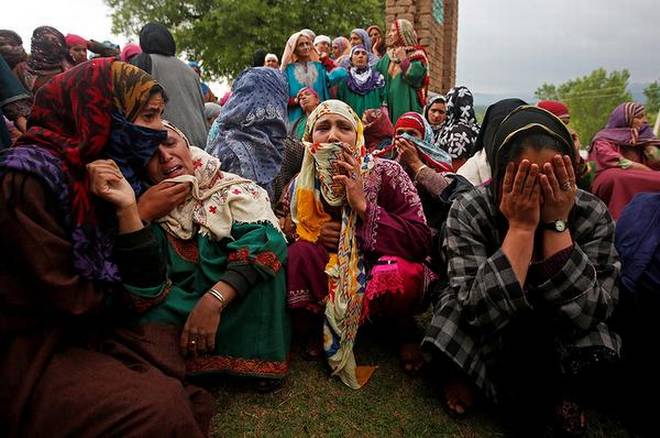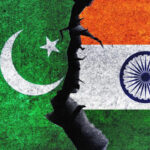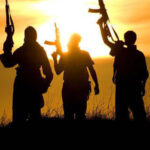No longer the sites of violent encounters, the laden orchards of south Kashmir hold the promise of peace
The cherry trees in Shopian’s Losedenow are weighed down with fruit.
It is just after the morning Sehri prayers that mark the beginning of the fast during Ramzan, and Pervaiz Ahmed Bhat and his family know they must move quickly.
The “suspension of operations”, what is called a conditional ceasefire or cease-ops, announced by the Union Home Ministry, has been in place for a week, and Mr. Bhat wants to maximise the time he can spend harvesting his crop of ‘Double Gilaas’ and ‘Misri’ cherry varieties this month.
Mr. Bhat hopes the cease-ops orders mean security restrictions will also be relaxed as, at present, they must submit identity cards to the security personnel and account for each family member going into the orchards, mentioning a fixed time for their return.
“I hope the cherries will reach the markets in time and won’t be damaged in storage rooms due to lockdowns of the security forces and the shutdowns sparked by killing of militants and civilians now,” said Mr. Bhat, particularly bitter about the frequent and intensive “Cordon and Search Operations” (CASO) that routinely disrupt life.
While the fruit hangs on the trees, the air in Shopian still hangs heavy with the memory of the bloodshed of the recent past. Laden with nature’s bounty, these orchards across four districts of south Kashmir — Anantnag, Pulwama, Kulgam and Shopian — have also doubled as hideouts for militants from these areas, and hence often became the unwitting sites of violent encounters and deaths.
The current wave of militancy is attributed to the killing of local boy Burhan Wani in 2016, one of a group of 11 militants who were famously photographed at an apple orchard here.
Last of 11
Three weeks ago, the last of the 11, Hizb-ul-Mujahideen district commander Saddam Paddar was killed in an encounter with security forces in Anantnag. Four other militants and five civilians were also killed and an estimated 118 protesters injured while trying to prevent the encounter.
At Paddar’s funeral, his mother Feroza Bano came out and fired a gun in the air amid thousands of mourners chanting slogans. Today the Paddar home in Shopian is silent, and Feroza Bano goes about her chores without a word. When asked about the cease-ops order, Saddam Paddar’s father says it must lead to a dialogue within Kashmir, especially with separatist leaders of the Hurriyat.
“Look around — how much property we have,” Mr. Paddar said. “Do you think unemployment drove my son to militancy? No; he joined to end oppression and laid his life for the dawn of azaadi [freedom],” he adds in a common refrain of martyrdom accorded to terrorists killed during operations.
Saddam Paddar was killed and buried alongside his neighbour Bilal Ahmad Mohand, 31. The facade of Mohand’s house is now covered with massive photographs of him holding a gun.
Emotive funerals
Militants would move around openly without even covering their faces, while neighbours and locals would crowd encounter sites to facilitate their escape and also turn out in large numbers at their funerals. In such a charged atmosphere, each funeral would become a recruiting ground for more youth to declare allegiance to terror groups, mainly the Hizb-ul-Mujahideen, but also the Pakistan-based Jaish-e-Mohammad. The new recruits would then disappear for training.
Short on weapons, these groups have had to procure guns by robbing police posts — nearly 150 guns and 100 grenades and tear gas shells have been stolen in the past three years. That isn’t a lot, admit security forces, but worrying enough for the announcement of a ban on smartphones for all policemen on guard duty to prevent them from being distracted and becoming easy prey.
“In terms of training and guns, the militants are novices and are not a big challenge for security forces,” a senior police official in Srinagar said. “Our biggest challenge is the loss of fear. After that our worry is the social sanctity that militants currently enjoy.”
Rising recruitment
As a result, records show that compared to 2006, when militancy was at a low, and locals would refuse to even bury a militant’s body, the numbers of those signing up for terror groups has increased steadily, from 12 in 2012, to 78 in 2015, to 126 in 2017. In the first four months of 2018 alone, 65 had turned to militancy, the police estimate.
A startling fact emerges from visits to the villages of these militants and statements from those arrested or who have surrendered: rather than religious ideology or secession, most of the men in their 20s and early 30s have taken to the gun because a friend or a neighbour had done so.
According to officials, this process is accelerated at funerals, and for each militant killed, two associates would be recruited. As a result, despite nearly 200 militants being killed in what the Army has called “Operation All Out”, each death led to a larger number taking up the gun. Senior sources in both the Prime Minister’s Office and the J&K Chief Minister’s office told The Hindu that these figures were the reason for the government’s decision to suspend all operations for the month of Ramzaan, which is likely to be extended past the Amarnath Yatra in July this year.
A week into the cease-ops, the absence of violence has had an immediate impact at schools and colleges across the Valley, but particularly in South Kashmir, where college officials say students averaged about two days of classes each fortnight in the last few months.
NGO workers like Tahmeed Mir are busy collecting stationary, colouring books and sports equipment like badminton racquets and cricket gear for school students. “The cease-ops is a small window of opportunity,” says Mr. Mir, “Lets hope it is extended to help students make up for all the disruptions.”
‘No Internet access’
At the Shopian Degree College there is an angry scene because some students have been informed that they have missed admission deadlines. “These students have had no access to internet, couldn’t go outside their homes. How are they expected to receive emails or finish admission formalities?” pleads Principal Dr. Ali Mehmood Dar on the telephone to University officials in Srinagar.
Accusing the government of failing to ensure their education, political science student Ghazala Wahid, 18, fires up at a college seminar, quoting dramatically from revolutionary poet Faiz Ahmad Faiz’s famous poem Arz e Watan, “The blood of how many do you need, my country, before your pale cheeks are rosy enough?”
Speaking in a soft voice from behind her veil, 22-year-old Humaira Dar, a final year medical student, Humaira Dar (22) says she is awaiting her final exams with some trepidation. When asked how she managed her studies without classes, tuitions or Internet access, she says she and her friends just “self-study” with textbooks.
Every student one speaks to says she or he knows they know someone injured or killed in the past few years, and this has weighed on their studies.
For the moment though, with spring in the air, fruit on the trees, and the possibility of a lull in violence, Humaira says she is breathing just a bit easier.






NO COMMENT